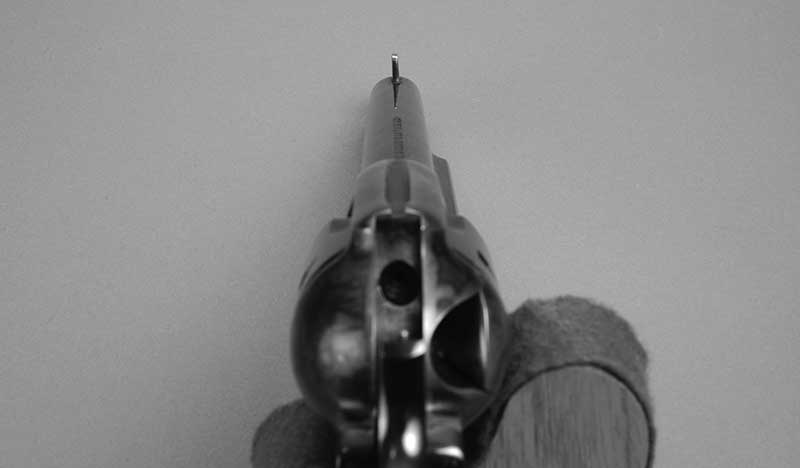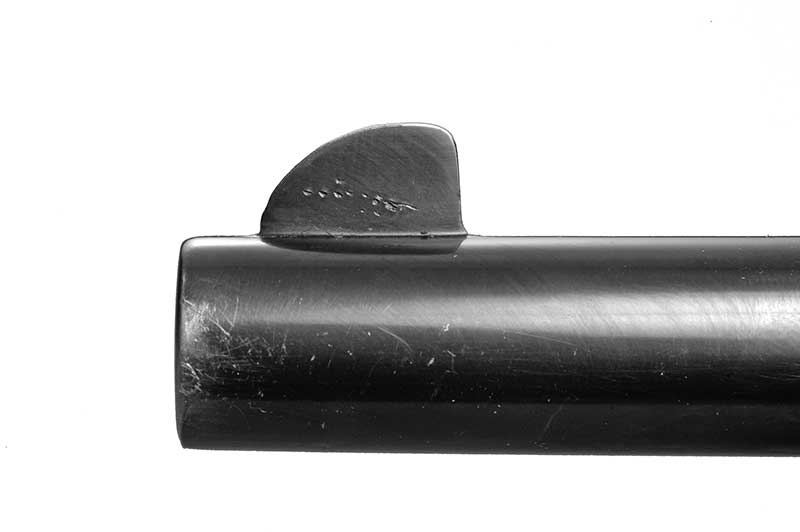Pliers And Files
In the spring of 1984 I was preparing to fly to Southern California to participate in my very first End Of Trail cowboy action match. I had only one misgiving. That was that my 3rd Generation Colt SAA .44-40 with 4¾” barrel put its bullets about 4″ left of where aimed at 25 yards. Such a thing is very annoying and likewise very common with single action revolvers.
Being impetuous by nature and letting annoyance transcend into anger I said to the Colt, “I’ll fix you!” I frequently talk to inanimate objects. Whereupon I rummaged through the pickup’s glove box until a pair of pliers was found. Then sans any sort of padding to protect it I gripped the Colt’s front sight and bent it to the left. I was surprised at how soft the sight’s steel was and one tweak had the .44-40’s point of impact matching point of aim. It still does too. A friend owns it now and takes great pleasure in showing the “plier tracks” on its front sight to anyone who will look, while telling them who mutilated it.
Other handgunners have said to me in wonder, “You actually bent the front sights of revolvers?” You bet I have. I’d take a hammer to them if that was needed to get them sighted properly. However, I freely admit the front sight on the second Colt SAA I did that do was of considerably harder steel and took much more effort to bend.
Actually bending front sights on revolvers wasn’t my original idea. The late Charles Askins once wrote that while a member of the Border Patrol in the 1930s that outfit received a shipment of Colt New Service .38 Special revolvers, most or all of which likewise placed bullets left of where aimed. He said he bent all their front sights until they were on. I copied him. At least one very annoyed reader copied me and wrote me saying his front sight came off when he tried that. So I guess the moral there is don’t copy me, like I copied Charlie?
Tool Savvy
If you have the least bit of handiness with tools in your makeup there’s a better method, and keep in mind this for single-action revolvers only. Drill a hole slightly smaller than the barrel diameter of your revolver through a block of hardwood. Then saw it in two directly down the center of the hole. Get some rosin from a hardware store and coat the blocks so they’ll grip the barrel. Dismount the single action’s ejector rod housing and lock the barrel in the blocks with the cylinder removed. Get a long piece of hardwood such as a broken shovel handle, insert it in the cylinder’s recess and then give the frame a gentle tweak. Key word here — gentle.
Now pay attention. You want to move the front sight in the opposite direction you want the bullet’s point of impact to move. Move the front sight towards where the bullets landed. Usually only a very slight tweak is necessary to move point of impact several inches at 25 yards. Moving the barrel counter-clockwise is most commonly necessary and that’s good because that’s tightening the barrel. Moving it clockwise is loosening the barrel, and just a tiny bit of movement in that direction goes a long way. Once a gunsmith no longer with us brought his portable vise to my home range and we sighted in every one of my single actions needing it. At least those not already suffering from bent front sights.
Now, I am so mechanically inept I don’t even do this myself anymore. The reason is my gunsmith buddy, Tom Sargis lives only a five minute drive away. With his barrel twisting setup permanently in place, I just run up there with any new single action needing adjustment.
Too Tall?
What about elevation? If the revolver shoots low then the remedy is filing off some of the front sight. That should be done very slowly, at the shooting range, test firing often. Elevation can also be adjusted slightly by changing bullet weight. As a rule, heavier bullets impact higher, lighter ones impact lower. If your revolver hits high, then you have a more of a problem. I’ve actually seen gunsmiths squeeze a single action’s front sight in a smooth jawed vice to make it taller and then file it to shape. Of course it gets narrower in the process. You’d better be very handy with tools to do that!
And here’s one last bit of common sense. Before you go to the trouble of sighting in your fixed-sight single action, have your load all figured out. If you change the load, then you risk changing the revolver’s point of impact. Then you get to do it all over again!

Get More Revolver Content Every Week!
Sign up for the Wheelgun Wednesday newsletter here:








